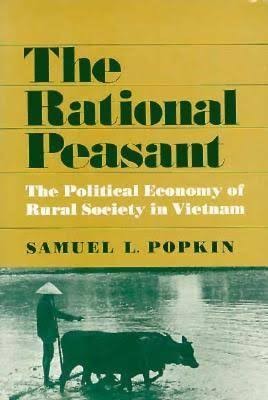Popkin's book offers ideas that, at least at times, directly confront those of James C. Scott (see quotes from one of his works here). This post continues the 'thought provokers' series of posts from The Rational Peasant (1979).
On assumptions of peasant life:
- "Some representations of preindustrial society idealize life in peasant villages. These romantic portraits of peasant life are greatly overdrawn and mislead us into thinking that the transformation of these societies is forced on the peasants and is always detrimental to their collective welfare. Exaggerating the virtues of the precapitalist village also results in erroneous diagnoses of the ailments of contemporary peasant society; these diagnoses lead in turn to misguided programs to remedy the ills. To understand the historical transformations or rural society and to develop effective programs for improving peasant welfare, we need to begin with a more accurate view of peasants and their institutions." (ix)
- "This is romanticism; this is the "myth of the village." A way of life that may have existed only for lack of alternatives is extolled as a virtue. Peasants who had little or nothing to eat are assumed to have had a rich spiritual life. Sons who may have stayed with their fathers only in order to survive are credited with filial piety. What may have been the absence of incentives to change becomes a resistance to innovation and a defense of traditional ways. The rich who hid their wealth are perceived as having shown great modesty, and hostility among villages is converted to village solidarity. Somehow what might have only have been the necessities or oppression of one era come to be interpreted as traditional values during the next." (3)
On moral and political economics:
- "Moral economists have argued that, from the perspective of peasant welfare, peasant society is moral, economically efficient, and stable. I, in contrast, will argue that none of these can be assumed. Moral economists take too benign a view of villages and patron-client ties and too harsh a view of market potential. They do not always look closely enough at the ways in which markets can benefit peasants nor at the structural factors that determine the impact a market (or a technology) will have on peasants. It is harder than they sometimes assume for peasants averse to risk (as moral economists recognize peasants to be) to make villages work well. Fuller attention must be paid to the ways in which aversion to risk affects intravillage (as well as market) relations, and more consideration must be given to conflicts between group and individual interests; it is also necessary to differentiate among the different types of crises that threaten peasants." (29-30)
- "Because villages do not provide extensive insurance or welfare, there does not have to be a crisis before peasants will involve themselves in commercial agriculture; their involvement is generally not a last-gasp response to declining situations, but a response to new opportunities." (33)
Re-imagining peasant life:
- "As James Scott has argued, "Commercial agriculture and the growth of the state … was to steadily reduce the reliability of subsistence guarantees to the point where peasants had hardly any alternative but resistance." Peasant protests are seen as restorative in nature: they seek to reinstate the traditional institutions and procedures menaced by capitalism; they are desperate responses to the threat of subsistence; they represent a collective response in the collective interest of the peasantry. But the facts of peasant movements in Vietnam challenge this interpretation in three ways. First, they movements are antifeudal, not restorative. They seek not to restore traditional practices and institutions, but to remake them; they seek not to destroy the market economy, but to tame capitalism. Second, there is no clear relationship between subsistence threat (or decline) and collective response. Third, the issue is not the extent of threat to a class, but the risk to individual participants…" (245-246)
1206 Hits

